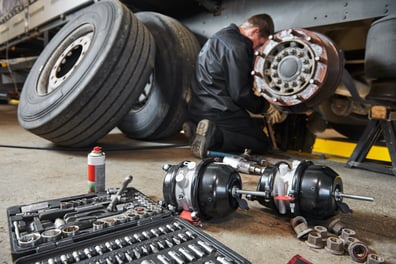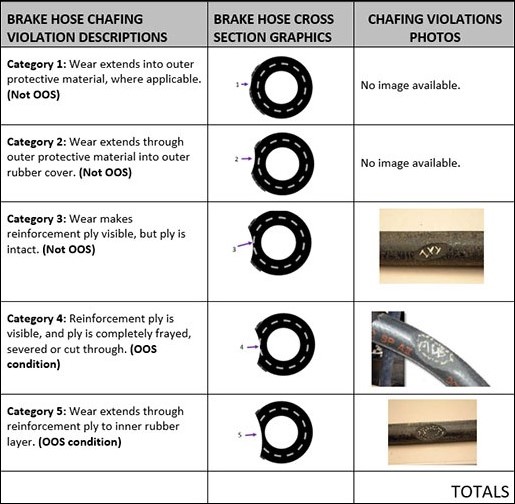Brake Safety Week is fast approaching - Is your fleet ready?

What is the most important operating component of a commercial motor vehicle (CMV)? Although there are many, the most important one is the part that makes the equipment stop - the brakes!! Brakes must always operate properly to ensure maximum safety. The braking system on CMV’s is designed for tough conditions, but it must be inspected and maintained carefully and consistently like anything. By doing this, the brake system will operate properly throughout the life of the truck.
Brake Safety Week will be held August 21-27, 2022, and was established in 1998 as an annual outreach and enforcement campaign to improve CMV brake safety and awareness throughout North America. More than 3.4 million brakes have been inspected since the program’s inception. It is sponsored by the Commercial Vehicle Safety Alliance (CVSA) in partnership with the U.S. Department of Transportation’s Federal Motor Carrier Safety Administration (FMCSA). During this week-long safety campaign, CMV inspectors will focus on conducting roadside brake system inspections on CMV’s to identify out-of-adjustment brakes and brake system violations.
Why is Brake Safety Week Necessary?

Brake-related violations comprise the largest percentage of all out-of-service vehicle violations cited during roadside inspections. Also, brake systems that are improperly installed or maintained can reduce the braking capacity and stopping distance of CMV’s, thus posing a severe risk to the driver and the public. During the 2021 Brake Safety Week, of the 35,764 commercial motor vehicles that were inspected, only 12% were restricted from travel or placed out of service due to critical brake-related conditions found during the inspection.
That also means that 88% of the CMV's inspected did not have a critical brake-related condition during the inspection and may have received the CVSA decal. This is a visual indicator to inspectors that the vehicle was recently inspected and had no critical inspection violations, valid for three months.
The Following is Typically Inspected During Brake Safety:
- Inspection of brake system components to identify:
- Loose or missing parts
- Air or hydraulic fluid leaks
- Torn linings, hoses, pads, drums, or rotors
- Additional faulty brake-system components
- Antilock braking systems (ABS) malfunction indicator lamps are also checked on the cab dash.
Defective or out-of-adjustment brakes will result in the vehicle being placed out of service and subsequent violation.
What should a motor carrier do to have a successful Brake Safety Week?
 When doing in-house maintenance, you must ensure that your technicians are certified to inspect and repair the components of the brake system both drum and disk per 49CFR – Part 396.25 “Brake Inspector Qualifications” Form 508.
When doing in-house maintenance, you must ensure that your technicians are certified to inspect and repair the components of the brake system both drum and disk per 49CFR – Part 396.25 “Brake Inspector Qualifications” Form 508.- In prior years, inspectors reported severe levels of brake hose chaffing and kinking violations during the inspection. This chart produced by CVSA shows the severity of chaffing from 1 to 5 along with what would constitute an out-of-service violation. Therefore, ensure that technicians check for any chaffing or kinking signs when performing scheduled maintenance. Just because it is not an Out of Service violation, does not mean that it should be ignored.
- Fleets should also ensure that their driver's complete inspections on their CMV’s daily for each vehicle operated per the Department of Transportation (DOT) regulations Part 396. Any deficiencies should be documented during the driver’s inspection and repaired before going on the road. Regarding the braking system, the driver can listen for audible air leaks, check low air signals and look for component damage.
- As for ABS-equipped CMVs, a properly functioning ABS malfunction lamp on the dash will turn on and off when power is supplied to the unit. If the ABS lamp does not illuminate, you likely have a malfunctioning system. Also, if the ABS lamp illuminates and stays on, it is another indication of a problem that must be checked and corrected. Both conditions indicate an ABS problem and will be documented as violations during a roadside inspection.
Since out-of-adjustment brakes and brake system violations represent almost half of all out-of-service violations issued to CMV’s on the road, attention must be taken to ensure that brake systems are properly installed, inspected, and maintained. These actions will improve CMV safety by reducing the number of highway crashes.
Need more information on Brake Safety Week: August 21-27,2022? It can be found via the link below.


%20Cropped.jpg)



